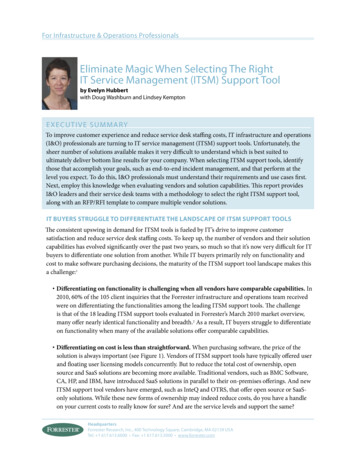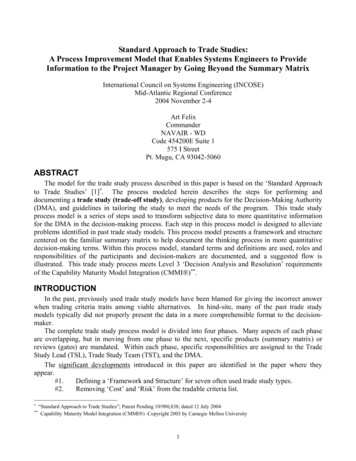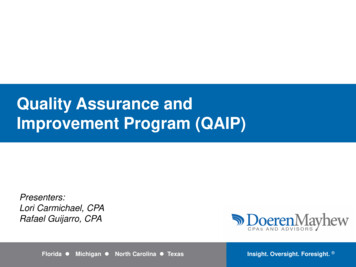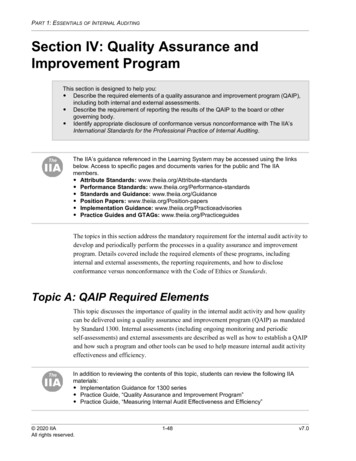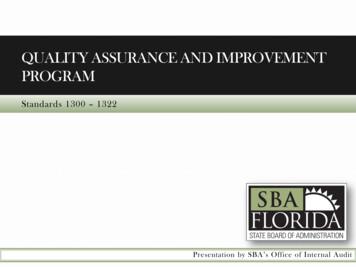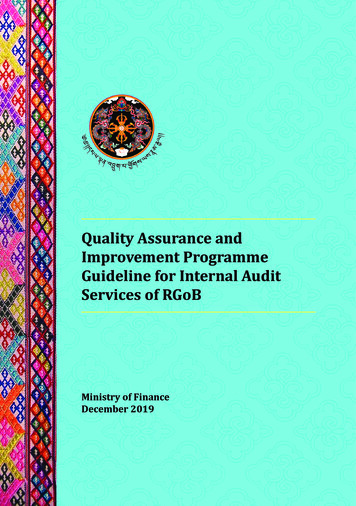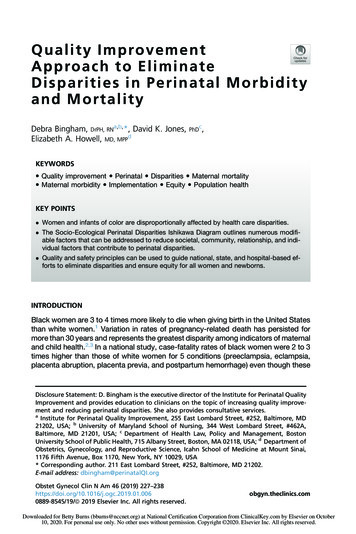
Transcription
Q u a l i t y I m p ro v e m e n tA p proac h t o El i mi n at eD i s p a r i t i e s in Pe r i n a t a l M o r b i d i t yand MortalityDebra Bingham, DrPH, RNa,b,*, David K. Jones,Elizabeth A. Howell, MD, MPPdPhDc,KEYWORDS Quality improvement Perinatal Disparities Maternal mortality Maternal morbidity Implementation Equity Population healthKEY POINTS Women and infants of color are disproportionally affected by health care disparities. The Socio-Ecological Perinatal Disparities Ishikawa Diagram outlines numerous modifiable factors that can be addressed to reduce societal, community, relationship, and individual factors that contribute to perinatal disparities. Quality and safety principles can be used to guide national, state, and hospital-based efforts to eliminate disparities and ensure equity for all women and newborns.INTRODUCTIONBlack women are 3 to 4 times more likely to die when giving birth in the United Statesthan white women.1 Variation in rates of pregnancy-related death has persisted formore than 30 years and represents the greatest disparity among indicators of maternaland child health.2,3 In a national study, case-fatality rates of black women were 2 to 3times higher than those of white women for 5 conditions (preeclampsia, eclampsia,placenta abruption, placenta previa, and postpartum hemorrhage) even though theseDisclosure Statement: D. Bingham is the executive director of the Institute for Perinatal QualityImprovement and provides education to clinicians on the topic of increasing quality improvement and reducing perinatal disparities. She also provides consultative services.aInstitute for Perinatal Quality Improvement, 255 East Lombard Street, #252, Baltimore, MD21202, USA; b University of Maryland School of Nursing, 344 West Lombard Street, #462A,Baltimore, MD 21201, USA; c Department of Health Law, Policy and Management, BostonUniversity School of Public Health, 715 Albany Street, Boston, MA 02118, USA; d Department ofObstetrics, Gynecology, and Reproductive Science, Icahn School of Medicine at Mount Sinai,1176 Fifth Avenue, Box 1170, New York, NY 10029, USA* Corresponding author. 211 East Lombard Street, #252, Baltimore, MD 21202.E-mail address: dbingham@perinatalQI.orgObstet Gynecol Clin N Am 46 (2019) 0889-8545/19/ª 2019 Elsevier Inc. All rights reserved.obgyn.theclinics.comDownloaded for Betty Burns (bburns@nccnet.org) at National Certification Corporation from ClinicalKey.com by Elsevier on October10, 2020. For personal use only. No other uses without permission. Copyright 2020. Elsevier Inc. All rights reserved.
228Bingham et alconditions were not more prevalent among black women than white women.4 Morethan twice as many black women than white women (4.2% compared with 1.5%) suffered from severe morbidity at the time of birth.5 Researchers have also shown thatblack women have had more inductions of labor, episiotomies, and cesarean birthsthan white women.6 In some cities, Hispanic women are more likely to suffer severematernal morbidities and have higher rates of pregnancy-related death than whitewomen.7,8 In addition, Hispanic infants are more likely to suffer morbidities, and blackinfants are twice as likely to die.9,10These haunting statistics clearly illustrate that disparities “are not simple differences, but rather inequities that systematically and negatively affect less advantagedgroups.”11 Inequities in perinatal health care are unacceptable, and quality and safetyinitiatives are needed to ensure equitable care for all women and newborns. Recentdata that demonstrate an increase in US maternal deaths during the past decade12highlight the dire need to decrease mortality and morbidity rates for all women andnewborns.A quality improvement (QI) approach has been successfully used to improve clinicaloutcomes, suggesting that QI can be a powerful tool to eliminating disparities. Forexample, universal newborn screening programs for metabolic disorders were successfully implemented in all hospitals, in all states more than 50 years ago.13 QI initiatives have also been used to achieve outcomes that were considered highlyimprobable. For example, neonatal intensive care unit (NICU) leaders recently reducedthe incidence of central line infections,14 an occurrence that was previously believedto be inevitable. In fact, some NICUs have gone more than a year without central lineinfections. This success required careful attention to details; every step in the processwas analyzed, and improvements were made as needed.The authors propose that the following 5 quality and safety strategies should beused to guide national, state, and hospital-based efforts to eliminate disparities in perinatal outcomes and to ensure equity for all women and newborns.STRATEGY 1: APPLY A SYSTEMS APPROACH BASED ON THE SOCIO-ECOLOGICALMODEL“Every system is perfectly designed to get the results it gets.”15 Our society and communities are currently perfectly designed to generate disparities in perinatal outcomes. But systems can be changed. The Socio-Ecological Model is commonlyused by public health leaders to guide systems approaches to analyzing and identifying solutions to complex problems. The key insight of this framework is that a person’s health is not just a function of his or her individual behaviors but also ofrelationships, factors present in the community, and societal context (Fig. 1). TheSocio-Ecological Model encourages a broad, non–health care centric, systemsapproach to help identify the root causes of perinatal disparities.Ishikawa cause-and-effect (fish bone) diagrams are used by quality and safetyleaders to understand the key components in a system that led to a failure or contributed to a poor outcome. The Institute for Perinatal Quality Improvement used the Ishikawa diagram format and the Socio-Ecological Model to develop the SocioEcological Perinatal Disparities Ishikawa Diagram (Fig. 2). This diagram outlinesnumerous modifiable, system-level factors that can contribute to perinatal disparities.For example, hiring, orientation, and training practices may not be as comprehensiveand may be shorter in duration for nurses among various hospitals. As a result, nursesat one hospital may be less skilled than those at another hospital, and this will affectoutcomes.Downloaded for Betty Burns (bburns@nccnet.org) at National Certification Corporation from ClinicalKey.com by Elsevier on October10, 2020. For personal use only. No other uses without permission. Copyright 2020. Elsevier Inc. All rights reserved.
Eliminating Perinatal Disparities229Fig. 1. Socio-Ecological Model.Another system-level community factor is perinatal nurse staffing ratios, which varyfrom hospital to hospital.16 Hospitals at which black women give birth may have lowernurse to patient ratios, thus fewer nurses are available to monitor patients, mobilize theteam should a patient’s condition deteriorate, provide routine care, and develop andimplement QI initiatives. In a study of labor nurses, participants indicated that whenthey were too busy, they missed essential components of care, including complete review of the patient’s history, prenatal records, and laboratory results; timely monitoring; and timely examinations.17 These examples illustrate factors that can bemodified to eliminate or greatly reduce disparities in perinatal outcomes.STRATEGY 2: IDENTIFY ROOT CAUSES OF DISPARITIESThe first step toward reducing disparity and ensuring equity is exploring the rootcauses, drivers, or social determinants of perinatal disparities within our communitiesand facilities. A root cause analysis requires being open to learn, change, listen, andsee what may not have been seen previously.One QI approach to finding root causes is to ask “why?” multiple times. Forexample, if a woman is late or misses her prenatal appointment, stop and ask“why?” Do not rely solely on your assumptions. Instead, consider asking her (in anonjudgmental way) why she was late. Consider all the barriers she may have facedto get to the appointment (eg, child care, transportation, work, school). The locationDownloaded for Betty Burns (bburns@nccnet.org) at National Certification Corporation from ClinicalKey.com by Elsevier on October10, 2020. For personal use only. No other uses without permission. Copyright 2020. Elsevier Inc. All rights reserved.
230Bingham et alDownloaded for Betty Burns (bburns@nccnet.org) at National Certification Corporation from ClinicalKey.com by Elsevier on October10, 2020. For personal use only. No other uses without permission. Copyright 2020. Elsevier Inc. All rights reserved.Fig. 2. Socio-Ecological Perinatal Disparities Ishikawa Diagram. (Courtesy of Copyright owned by the Institute for Perinatal Quality Improvement, www.perinatalQI.org, 2018, All rights reserved. Reprinted with permission.)
Eliminating Perinatal Disparities231and hours of the clinic, public transportation schedules, and her lack of social supportmay affect her ability to get to the office. Similarly, it is critical to explore thoroughly theroot causes of all sentinel events, near-miss events, and errors by asking “why?” Arobust reporting system that encourages individuals to report, explore, and learnfrom poor outcomes is an effective way to identify root causes.One major root cause of disparities is structural racism, the seen and unseeninteraction among policies, practices, and institutions that perpetuate barriers preventing women and infants of color from receiving equitable and safe healthcare.18 A root cause analysis can help uncover structures that contribute to disparities or inequity in the provision of care. Structural racism is perpetuated byconscious and unconscious bias and must be identified, better understood, andchanged. For example, a clinician may blame black and Hispanic women for worseperinatal outcomes by assuming their behaviors reflect poor choices. However,disparities in health and health care are driven by a complex web of factors. Arecent summary of epidemiologic studies about disparities in preterm birth ratesconcluded that place matters: not because of geography but because of systemicand structural dynamics present in social and political institutions.19 Many moreblack women than white women live in “food deserts”20 with few healthy food options or in “food swamps”21 with limited healthy food options. In addition, highercrime rates in low-opportunity neighborhoods make it much riskier to go for awalk, play at the park, or even read a book in your own home. The cumulative effects of these negative experiences during a lifetime are not modifiable by theindividual.22Many clinicians routinely perpetuate structural racism. Physicians, nurses, and midwives, whose life work is dedicated to the care and healing of others, may be particularly resistant to acknowledging their roles in sustaining structural racism. Yet thefacts demonstrate variation in the quality of care provided at different hospitals. Forexample, the risk of severe maternal morbidity at one hospital can be 6 times greaterthan the risk at another hospital, even after accounting for patient risk factors.5 Notsurprisingly, black and Latina women are more likely to give birth at hospitals withworse outcomes.5 A black woman with the same risk factors as a white woman ismore likely to experience severe maternal morbidity because of where she gives birth.In New York City, nearly 1000 black women could avoid severe morbidity during theirbirth hospitalizations each year if they gave birth at the same hospitals as whitewomen.5Numerous factors in Fig. 2 could benefit from thorough, root cause analyses. Forexample, inappropriate and derogatory comments, such as “those women nevertake care of themselves” or “abuse the Medicaid system” are considered acceptable by some clinicians. It is important to determine the root cause of these comments and to ensure that all clinicians receive implicit bias training to prevent suchcomments from being made and tolerated in the future. Bias training helps clinicians become more aware of how their conscious and unconscious assumptionsaffect how they provide care to women of color. Bias can also manifest itself inmany subtle ways, such as discounting racial and ethnic patients’ symptoms orfailing to adequately listen when women complain of pain. Implicit bias trainingwas recommended by the Council on Patient Safety in Women’s Healthcare asone strategy to reduce disparities because it has been shown to change attitudesand behaviors.11Women of color may feel uncomfortable asking questions because of how theywere previously treated by health care providers. These experiences may affect theirability to trust the current health care team. Other community factors could beDownloaded for Betty Burns (bburns@nccnet.org) at National Certification Corporation from ClinicalKey.com by Elsevier on October10, 2020. For personal use only. No other uses without permission. Copyright 2020. Elsevier Inc. All rights reserved.
232Bingham et alexplored through root cause analysis. For example, a nurse manager could explorethe lack of diversity among the nurses who work on the labor and delivery unit. Thisroot cause analysis may reveal that recruiters do not seek out graduates with diverseracial and ethnic backgrounds. Alternatively, personnel hiring and on-boarding practices may prevent a racially diverse work force, without which the team will lackdifferent perspectives and life experiences.STRATEGY 3: IDENTIFY AND ELIMINATE STRONG BUT WRONG ROUTINES“Hospital quality may be a critical lever for improving outcomes and narrowing disparities.”23 All routines should be scrutinized and improved; however, a barrier tothis process is that “strong but wrong routines”24 are woven throughout clinicalcare. These routines are so thoroughly ingrained that it is difficult for clinicians torecognize how they contribute to deaths and injuries of women in the perinatalperiod. For example, for many years, estimation of blood loss at birth remained common practice despite research as early as the 1960s that demonstrated its inaccuracy.25 In 2008, the California Maternal Quality Care Collaborative reviewedmaternal deaths and pointed out that quantification of blood loss was possibleand preferable. From this point, clinical practice is changing from estimation to quantification of blood loss.26,27Openly discussing deaths, errors, and near-miss occurrences helps to identifystructures and processes that need to be improved. Indeed, among high-reliability organizations, leaders routinely scrutinize their behavior, proactively look for potentialproblems, and seek to eliminate what may seem like the smallest of errors.27 Deaths,errors, or cases of morbidity provide opportunities for learning that can lead to crucialchanges. High reliability organizations establish cultures in which it is psychologicallysafe and desirable to discuss mistakes and proactively look for possible errors. Theypromote cultures that avoid blame and shame.28Although individual clinicians may not have the authority to write policies for organizations, they can influence changes in practice by admitting their mistakes and identifying when a mistake was almost made irrespective of the outcome. As the Instituteof Medicine emphasized, “to err is human,”29 and no clinician is perfect. All clinicianswill make mistakes at some time in their careers. The true test of clinicians’ mettle ishow they handle these occurrences.Racist words and actions, just like medication errors, contribute to the preventabledeaths of women and infants. Racist jokes, comments, structures, or practices maybe strong but wrong routines that perpetuate a culture of disrespect and differences inhow women and infants of color are cared for. These routines may be even harder to identify and change than procedure or medication errors because many are unconscious, orinvisible, to individuals. Racist actions or words should be identified and addressedthrough reviews in the same way other health care errors are identified and reviewed.The SPEAK UP for Black Women campaign, developed by the Institute for PerinatalQuality Improvement, encourages health care professionals (hospital administrators,clinicians, and public health leaders) to speak up against racism whenever they seeracist behaviors or hear racial slurs. Individual clinicians have the power and responsibility to change the discourse (verbal, nonverbal, written) in which they participate.These types of discourse indicate the culture of an organization and how rapidlychange will occur.30 Clinicians who witness differences in care or disrespect of patients because of their race or ethnicity and do not speak up are complicit in racism.The SPEAK UP campaign encourages clinicians to receive implicit bias training and tosign the SPEAK UP pledge (Fig. 3).Downloaded for Betty Burns (bburns@nccnet.org) at National Certification Corporation from ClinicalKey.com by Elsevier on October10, 2020. For personal use only. No other uses without permission. Copyright 2020. Elsevier Inc. All rights reserved.
233Fig. 3. The SPEAK UP campaign. (Courtesy of Copyright owned by the Institute for PerinatalQuality Improvement, www.perinatalQI.org, 2018, All rights reserved. Reprinted withpermission.)Downloaded for Betty Burns (bburns@nccnet.org) at National Certification Corporation from ClinicalKey.com by Elsevier on October10, 2020. For personal use only. No other uses without permission. Copyright 2020. Elsevier Inc. All rights reserved.
234Bingham et alSTRATEGY 4: USE IMPROVEMENT AND IMPLEMENTATION SCIENCE METHODS ANDTOOLS“Implementation research is the scientific study of methods to promote the systematicuptake of research findings and other evidence-based practices into routine practice,and, hence, to improve the quality and effectiveness of health services and care.”31Improvement science is related to but different from implementation science.Improvement science is defined as an applied science that emphasizes innovation,rapid-cycle testing in the field, and spread to generate learning about what changes,in which contexts, produce improvements.32 Implementation science and improvement science is used to guide the development, implementation, evaluation, anddissemination of QI initiatives that are designed to expand the use of evidencebased care.Set SMART Goals and BenchmarksQI leaders need to set goals and benchmarks. SMART goals are Specific, Measurable,Achievable, Relevant, and Time-bound. Too often the QI goals are set at 80% or 90%,rather than at 100%. Leaders and staff may also stop trying to make improvements iftheir goals are set too low.33 Benchmarks with interim goals help the group track andmake progress. However, once a benchmark is achieved, a new interim goal shouldbe set until the improvements reach the ultimate goal of 100% of the population. Goalsand benchmarks should be set so that they can be compared with those of other hospitals and states. Comparing outcomes in one hospital with other hospitals expandsthe work beyond the local context, which is often useful to identify areas in which additional improvements are needed.QI leaders must work to ensure that vulnerable populations are included in all QI initiatives. To claim success and stop our efforts before we have made improvements foreveryone leaves part of the population behind. The women and infants who are leftbehind may be the part of the population that needs the improvements the most.The work of quality and safety leaders is not completed until every woman and infant’soutcomes are improved.Start with Small Tests of Change Using a Quality Improvement Process ModelOne of the first places to begin tackling a complex issue, such as reducing perinataldisparities, is to ensure that all women and infants have access to evidence-based interventions. These include safety protocols to standardize care, triggers, checklists,enhanced communication, and teamwork. Three QI implementation strategies usedby leaders are education, discourse, and data.34 Specific tactics can be used withineach strategy. Many types of educational tactics can be used in QI initiatives. TheQI leader can use academic detailing (one-on-one discussion of an academic article),classroom education, and online education. Discourse tactics can include staff meetings, bulletin board displays, and e-mails. Data tactics can include graphs, infographics with both data and images that illustrate the data, and dashboards.Sustain ImprovementsCompeting priorities were identified as a significant threat to sustaining the gains of aQI initiative.35 Whenever the QI leaders begin to introduce new QI initiatives, they alsoneed to perform periodic surveillance because it is important to know whether the previous successes are being sustained. Effective continual surveillance provides alerts.Ongoing surveillance is particularly important when working to reduce long-standingperinatal disparities.Downloaded for Betty Burns (bburns@nccnet.org) at National Certification Corporation from ClinicalKey.com by Elsevier on October10, 2020. For personal use only. No other uses without permission. Copyright 2020. Elsevier Inc. All rights reserved.
Eliminating Perinatal Disparities235STRATEGY 5: USE DATA TO GUIDE THE PLAN AND TRACK PROGRESSData form the foundation of system thinking, root cause analyses, and QI methods. QIleaders need to be thoroughly informed about how data are collected and presentedto ensure that no racial group or ethnicity is risk adjusted out of their hospital’s QI data.Data variation is how QI leaders identify opportunities for improvement.Donabedian’s36 structure, process, and outcomes QI data measurement categoriesare a practical way to use and categorize data to guide QI efforts. These data categories are useful when developing the QI metrics to assess, plan, and track QI progress. Balancing measures, especially when working to make improvements inmaternal outcomes, also may be needed. It is important to have a balance betweenmaternal and neonatal measures to ensure that a QI effort designed to reduce cesarean births, for example, does not lead to negative, unintended consequences for theinfants.Structural changes, such as improving an electronic health record, developing anew policy and procedure, or providing education for the clinical staff, make it easierfor clinicians to do the right thing. Structural changes are especially necessary whenworking to eliminate perinatal disparities. For example, ensuring that more womenand men of color are admitted to medical and nursing schools and are hired towork in the outpatient and inpatient settings is a needed change. Only by achievinga diverse workforce will we be able to serve the needs of our ever-increasing diversityof patients. Further, unconscious bias training needs to be implemented in medicalschools, nursing schools, and hospitals to help recognize our own biases and serveour patients better. Structural changes that will reduce disparities could includemore convenient clinic hours, making it more accessible for the most vulnerable populations or implementing implicit bias training. Structural changes may be the changesthat take the longest to make, but structural changes are worth the effort because theyare the hardest to circumvent.Process measures, such as quantification of blood loss, performing risk assessments, and accurately taking a blood pressure, are focused on changing clinicians’behaviors. Examples of a disparity-related process measure is to implement morerespectful dialogue among the clinicians, change hiring practices, and change onboarding practices. Outlining examples of what is and is not respectful speech and actions and performing role playing are tactics that can be used to successfully implement these process improvements.Rates of severe maternal morbidity and mortality are an example of an outcomemeasure. Data need to be analyzed and presented in such a way that any differencesin outcomes by race and ethnicity are easy to identify. QI data need to be designed sothat outcomes of different racial and ethnic groups can be easily compared within ahospital, across hospitals, communities, regions, and nationally. Hospital-level severematernal morbidity data showed a wide variation in black women compared with whitewomen.5 These data provide the opportunity for further explorations. For example, thehospitals with the highest rates of severe maternal mortality should perform a formalroot cause analysis to determine why their rates are higher than other hospitals. Inaddition, there also can be disparities within the same hospital.5 Knowing the differences in severe maternal morbidity for black women compared with white women,especially if the black women gave birth at the same hospital as the white women,will help support the root cause analysis that will guide the development and implementation of a targeted QI initiative. Recording race and ethnicity birth data as accurately as possible is a recommendation from the Council on Patient Safety and iscritical to the success of QI efforts designed to eliminate preventable disparities.11Downloaded for Betty Burns (bburns@nccnet.org) at National Certification Corporation from ClinicalKey.com by Elsevier on October10, 2020. For personal use only. No other uses without permission. Copyright 2020. Elsevier Inc. All rights reserved.
236Bingham et alSUMMARYA disproportionate number of women and infants of color are suffering preventableharm in the United States resulting in the premature loss of life. These losses createa cascade of negative effects across multiple generations. Each maternal death canresult in grandmothers, grandfathers, aunts, uncles, friends, and communities stepping in to raise a motherless child. Each loss of a child results in excruciating and lifelong pain for mothers, fathers, and families. These premature losses put families ofcolor at a disadvantage over the life-course.More than half of maternal deaths are preventable.37–39 We must act now to increase our QI capacity if we are to reduce the 17-year lag time between knowingand doing.40 Applying QI principles to the complex, multifaceted goal of ensuring perinatal equity for all women is an important start to mapping out and implementing acourse of action. When trying to resolve complex issues and make important changes,we can be energized and encouraged by what Margaret Meade said: “never doubtthat a small group of thoughtful, committed citizens can change the world; indeed,it’s the only thing that ever has.”41REFERENCES1. Creanga AA, Syverson C, Seed K, et al. Pregnancy-related mortality in the UnitedStates, 2011-2013. Obstet Gynecol 2017;130(2):366–73.2. Centers for Disease Control and Prevention. Differences in maternal mortalityamong black and white women - United States, 1990. MMWR Morb MortalWkly Rep 1995;44(1):6–7, 13–14. Available at: .htm. Accessed October 12, 2018.3. Berg CJ, Chang J, Callaghan WM, et al. Pregnancy-related mortality in the UnitedStates, 1991-1997. Obstet Gynecol 2003;101(2):289–96. Available at: 3/02000/Pregnancy Related Mortalityin the United States,.15.aspx. Accessed October 12, 2018.4. Tucker MJ, Berg CJ, Callaghan WM, et al. The black-white disparity inpregnancy-related mortality from 5 conditions: differences in prevalence andcase-fatality rates. Am J Public Health 2007;97(2):247–51.5. Howell EA, Egorova NN, Balbierz A, et al. Site of delivery contribution to blackwhite severe maternal morbidity disparity. Am J Obstet Gynecol 2016;215(2):143–52.6. Grobman WA, Bailit JL, Rice MM, et al. Racial and ethnic disparities in maternalmorbidity and obstetric care. Obstet Gynecol 2015;125(6):1460–7.7. Howell EA, Egorova NN, Janevic T, et al. Severe maternal morbidity among Hispanic women in New York City: investigation of health disparities. Obstet Gynecol2017;129(2):285–94.8. New York City Department of Health and Mental Hygiene. Severe maternal morbidityin New York City, 2008–2012 2016. Avaialable at: /maternal-morbidity-report-08-12.pdf. Accessed September 28,2018.9. Howell EA, Janevic T, Hebert PL, et al. Differences in morbidity and mortality ratesin black, white, and Hispanic very preterm infants among New York City hospitals.JAMA Pediatr 2018;172(3):269–77.10. Matthews TJ, MacDorman MF, Thoma ME. Infant mortality statistics from the 2013period linked birth/infant death data set. Natl Vital Stat Rep 2015;64(9):1–30.Avaialable at: https://www.cdc.gov/nchs/data/nvsr/nvsr64/nvsr64 09.pdf. Accessed October 12, 2018.Downloaded for Betty Burns (bburns@nccnet.org) at National Certification Corporation from ClinicalKey.com by Elsevier on October10, 2020. For personal use only. No other uses without permission. Copyright 2020. Elsevier Inc. All rights reserved.
Eliminating Perinatal Disparities23711. Howell EA, Brown H, Brumley J, et al. Reduction of peripartum racial and ethnicdisparities: a conceptual framework and maternal safety consensus bundle.J Obstet Gynecol Neonatal Nurs 2018;47:275–86.12. GBD 2015 Maternal Mortality Collaborators. Global, regional, and national levelsof maternal mortality, 1990-2015: a systematic analysis for the Global Burden ofDisease Study 2015. Lancet 2016;388(10053):1775–812.13. Brosco J, Grosse S, Ross L. Universal state newborn screening programs canreduce health disparities. JAMA Pediatr 2015;169(1):7–8.14. Mobley RE, Bizzarro MJ. Central line-associated bloodstream infections in theNICU: successes and controversies in the quest for zero. Semin Perinatol2017;41(3):166–74.15. IHI Multimedia Team. Like magic? (“Every system is perfectly designed.”).2015. Available at: ery
A quality improvement (QI) approach has been successfully used to improve clinical outcomes, suggesting that QI can be a powerful tool to eliminating disparities. For example, universal newborn screening programs for metabolic disorders were suc-cessfully implemented in all hospitals, in all sta




